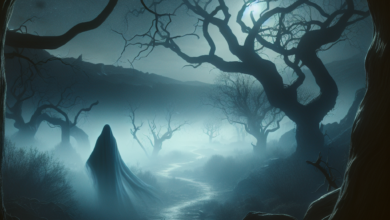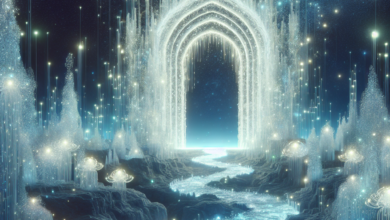In the quiet village of Eldridge Hollow, nestled deep within the rolling hills of the English countryside, there lay a legend that sent shivers down the spines of even the most sceptical inhabitants. The tale spoke of a forgotten relic, a tarnished locket said to possess a power that transcended time itself. It belonged to Lady Eleanor Winslow, a woman of great beauty and tragic fate, who had once graced the halls of Eldridge Manor with her elegance and grace.
The manor, now a crumbling structure of grey stones entwined with ivy, had long been abandoned. Shadows danced in its broken windows, and whispers of the past lingered in the air like the scent of damp earth after a rainstorm. A fierce storm raged one October evening, as the villagers gathered in The Fox and Hounds tavern, the flickering candlelight casting erratic shadows. The wind howled like a grieving banshee, and the townsfolk, seeking warmth from the storm, began to share the chilling tale of Lady Eleanor.
Many years ago, she had been betrothed to the dashing Lord William Harrington, a union that was the envy of all. But on the eve of their wedding, Eleanor vanished without a trace. Her mother had claimed she simply could not bear the weight of expectation; others whispered of jealousy and betrayal, while a few dared to suggest that a dark curse had befallen the Winslow family. In the weeks that followed Eleanor’s disappearance, various villagers reported seeing her spectral figure roaming the forgotten gardens of the manor, her face a mask of sorrow.
Time passed, and the legend faded, along with the memory of Lady Eleanor, until one day, a curious scholar named Arthur Finch stumbled upon the locket while researching local history. The relic was buried beneath a false floorboard in the remains of Eldridge Manor, draped in dust and forgotten by all but the shadows. It shone brightly against the dark wood, the delicate engraving of a rose still visible after all those years. Arthur felt an inexplicable pull towards it, as if the very essence of Lady Eleanor sung to him through the years.
Once he unearthed the locket and held it in his palm, a chill enveloped his heart. Something about the locket felt alive, imbued with the sorrow and longing of its former owner. Yet it was also a thing of beauty, and he couldn’t resist the urge to take it back to his modest cottage at the edge of the village. As night fell, he laid the locket on his desk, the candlelight flickering around it like the heartbeat of ghosts.
From that night on, unease settled upon Arthur’s heart, punctuated by vivid dreams that transported him back to the days of Lady Eleanor. He wandered through moonlit gardens, where roses bloomed in hues of crimson and shadows whispered tales of lost love. Each night, the dreams grew more intense, and he began to awaken in a cold sweat, the sound of a woman weeping echoing in his mind.
As days turned into weeks, the whispers in the village grew louder, and Arthur became an unwilling participant in conversations drenched in hushed fear. The townspeople spoke of strange occurrences: livestock disappearing without a trace, odd lights glimmering in the ruins of Eldridge Manor, and, most disturbingly, sightings of a woman in white gliding through the village streets. They believed Eleanor had returned, and not simply as a ghost but as a harbinger of doom, spurred to reclaim what was taken from her.
Driven by an insatiable curiosity and a growing sense of dread, Arthur returned to the ruins of the manor. The sky was cloaked in a curtain of grey, and the air was thick with the scent of impending rain. As he crossed the threshold, he felt as though he were stepping back in time. The air inside was heavy with forgotten memories, and the very walls ached with the weight of sorrow.
In the heart of the manor lay a room untouched by time, the remnants of a lavish chamber preserved beneath a layer of dust. It was in this room that Arthur first glimpsed her—a figure cloaked in moonlight, her raven hair cascading over pale shoulders, her gown a spectral white. Lady Eleanor hovered near the window, gazing longingly into the distance, her gaze distant and sorrowful.
“Why have you come here?” she whispered, her voice a gentle breeze that carried both sadness and a hint of pleading. Arthur’s heart raced, yet a strange calm settled over him as he took a step toward her. He felt compelled to speak, but the words caught in his throat.
“I found your locket,” he stammered finally, raising it between them. Her eyes, once cold and distant, ignited with a fire of recognition, a longing that seemed to reach out like lithe fingers grabbing at dreams.
“The locket… it holds my heart, but it has also brought me torment. A curse has befallen me, entwining my spirit to this place, until the truth is uncovered, and I can rest,” Eleanor implored, sadness spilling from her words like rain tumbling from a broken sky. “I cannot move on. You must help me.”
In his heart, Arthur felt a resolute urgency bound to her anguish. Over the days that followed, whenever storm clouds blotted out the sun, Arthur returned to the manor, drawn to Eleanor like a moth to flame. She spoke of her love for Lord William, of the fateful night where jealousy intertwined with betrayal, sealing her doom.
“The truth must be brought to light,” she urged. “Find William’s journal; it holds the key. It reveals not just the man but the darkness that surrounded our love.”
Driven by her words, Arthur scoured the dusty remains of the manor, searching for the truth amongst the remnants of a life long past. After days of fruitless searching, he finally stumbled upon a trapdoor in the cellar, hidden beneath the rotting floorboards. Its hinges creaked as he pried it open, revealing a small vault. Amidst the cobwebs lay a leather-bound journal, pages yellowed with age.
As he read, a chill carved his spine. The journal recounted not only the romance he had imagined but also a history steeped in treachery. It spoke of a rival who sought to destroy Lord William out of greed and envy—an enemy cloaked in the guise of a friend. Torn between envy and love, he learned that Eleanor’s disappearance was not a choice but a cruel manipulation that led to her untimely fate.
Bolstered by this newfound knowledge, Arthur was compelled to confront the villagers. He gathered the townsfolk in The Fox and Hounds and recounted the tale hidden within the journal. As the story unfolded, gasps punctuated the silence, and disbelief gave way to an understanding that crossed generations. They had been blind to the truth, shackled by fear of a curse that was never theirs to bear.
That night, while the storm rumbled in the distance, the village pooled together, heading toward Eldridge Manor. The haunting echoes of Lady Eleanor’s sorrow reached them, urging them on. Arthur led the way, vintage lanterns illuminating the path, as they arrived beneath the manor’s tomb-like structure.
With a newfound strength illuminating the night, they gathered in the wilted garden where roses curled under the weight of time. There, in a solemn circle, Arthur recounted Eleanor’s tragedy once more, honouring her spirit and unveiling the truth. As he spoke the final words, a soft, ethereal light blossomed in the air, and Lady Eleanor appeared beside him, her visage radiant and peaceful.
“Thank you,” she whispered, a smile breaking the sorrow that had encased her for centuries. “You have freed me.”
With that, her spirit shimmered and began to ascend into the night sky, a gentle breeze enveloping the villagers. The storm that had raged for weeks finally calmed, giving way to a peaceful silence that descended upon Eldridge Hollow, as if the land itself breathed a sigh of relief.
And so, the Curse of the Forgotten Relic was lifted, fading into whispers carried by the wind. As dawn broke over Eldridge Hollow, the villagers awoke to a world transformed, unburdened by the shadows of the past and filled with the promise of peace that had long escaped them. As for Arthur, he continued to tell the tale, the memory of Lady Eleanor etched in his heart—a testament to love lost, truth revealed, and the haunting reminder that history, when forgotten, has a way of entangling itself with the living until the very end.





